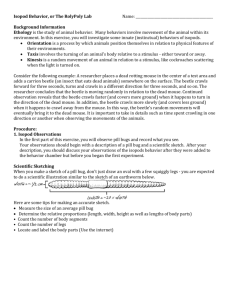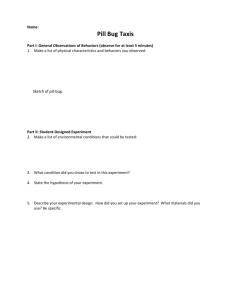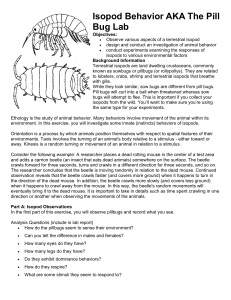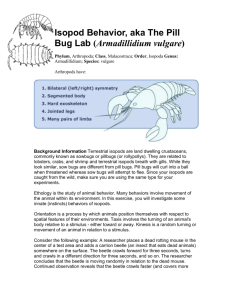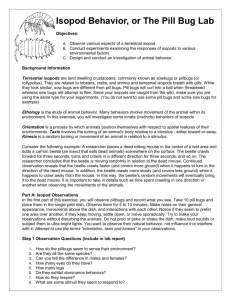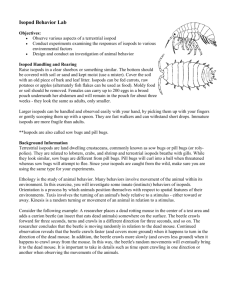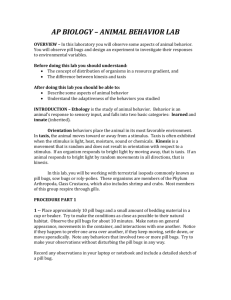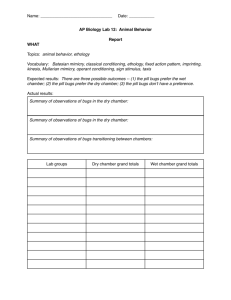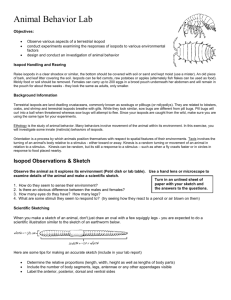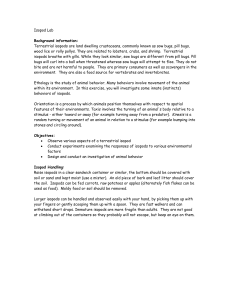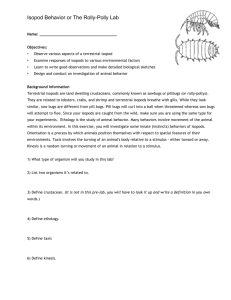isopods Lab AP Bio Pill Bug Behavior revised 1415_2
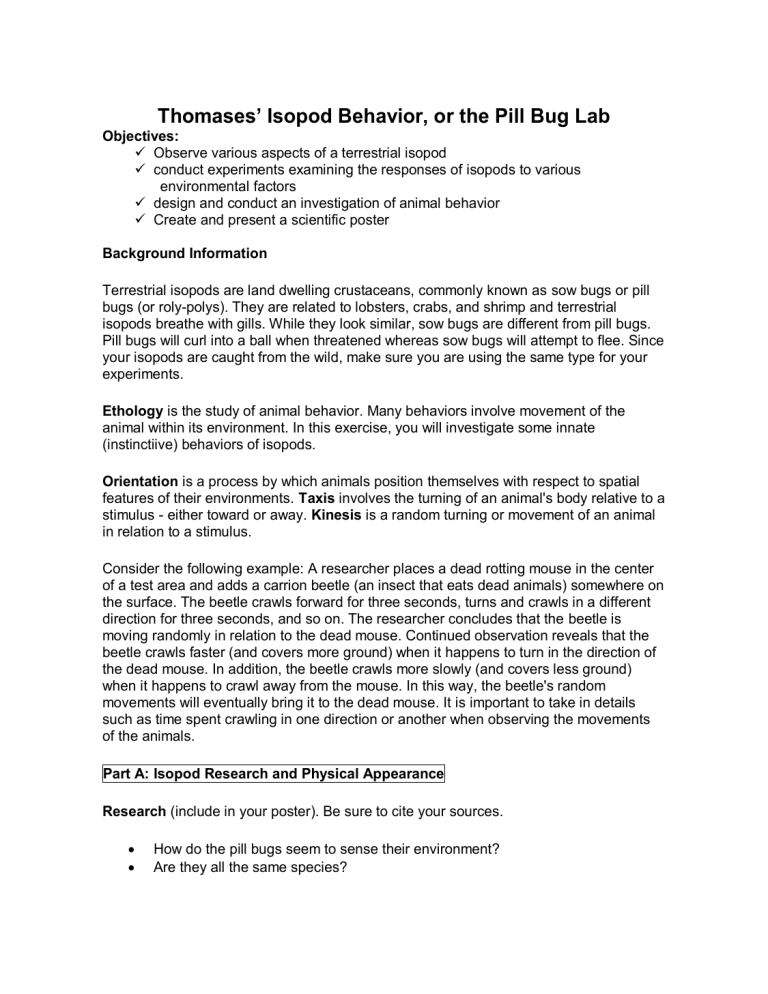
Thomases’ Isopod Behavior, or the Pill Bug Lab
Objectives:
Observe various aspects of a terrestrial isopod
conduct experiments examining the responses of isopods to various environmental factors
design and conduct an investigation of animal behavior
Create and present a scientific poster
Background Information
Terrestrial isopods are land dwelling crustaceans, commonly known as sow bugs or pill bugs (or roly-polys). They are related to lobsters, crabs, and shrimp and terrestrial isopods breathe with gills. While they look similar, sow bugs are different from pill bugs.
Pill bugs will curl into a ball when threatened whereas sow bugs will attempt to flee. Since your isopods are caught from the wild, make sure you are using the same type for your experiments.
Ethology is the study of animal behavior. Many behaviors involve movement of the animal within its environment. In this exercise, you will investigate some innate
(instinctiive) behaviors of isopods.
Orientation is a process by which animals position themselves with respect to spatial features of their environments. Taxis involves the turning of an animal's body relative to a stimulus - either toward or away. Kinesis is a random turning or movement of an animal in relation to a stimulus.
Consider the following example: A researcher places a dead rotting mouse in the center of a test area and adds a carrion beetle (an insect that eats dead animals) somewhere on the surface. The beetle crawls forward for three seconds, turns and crawls in a different direction for three seconds, and so on. The researcher concludes that the beetle is moving randomly in relation to the dead mouse. Continued observation reveals that the beetle crawls faster (and covers more ground) when it happens to turn in the direction of the dead mouse. In addition, the beetle crawls more slowly (and covers less ground) when it happens to crawl away from the mouse. In this way, the beetle's random movements will eventually bring it to the dead mouse. It is important to take in details such as time spent crawling in one direction or another when observing the movements of the animals.
Part A: Isopod Research and Physical Appearance
Research (include in your poster). Be sure to cite your sources.
How do the pill bugs seem to sense their environment?
Are they all the same species?
Can you tell the difference in males and females?
How many eyes do they have?
How many legs
Do they exhibit dominance behaviors?
How do they respire?
What are some stimuli they seem to respond to?
Scientific Sketch
When you make a sketch of a pill bug, don't just draw an oval with a few squiggly legs - you are expected to do a scientific illustration similar to the sketch of an earthworm below.
Here are some tips for making an accurate sketch (include in your lab report)
Determine the relative proportions (length, width, height as well as lengths of body parts)
Count the number of body segments
Count the number of legs
Locate and label the body parts
Note the size of the pill bug
Part B – Observations and Orientation of Isopods Due to Environmental Changes
Protocol 1: Set up your behavior chamber so that you have one side moist and one side dry (using paper towels). Transfer 10 isopods to the chamber. Count and record the number of animals in each of the chamber every 30 seconds for 15 minutes , using a data table.
Protocol 2: Custom Behavior Chamber .
For the experiments you design, you will need to create a chamber to test the isopods reactions. Each basic chamber will consist of at least four sides, each side having a different environment. You will have to bring the materials. How you design the chamber is up to you and your partners Write a hypothesis i n the form of an “If…then…”statement. Collect data on the position of the pill bugs.
Create a hand drawn graph of your data. Write a conclusion.
Poster requirements ( Be sure to use the words in bold type found in the introduction of this lab sheet.)
1. Research (Cite your sources)
2. Scientific sketches
3. Type your experimental question.
4. Protocol 1. Describe protocol 1 and briefly summarize the results
5. Protocol 2: Write your procedure and sketch your apparatus.
6. Write a hypothesis for your custom procedure in the form of an “if…then...” statement
Poor: I think pill bugs will move toward the wet side of a choice chamber.
Better: If pill bugs prefer a moist environment, then when they are randomly placed on both sides of a wet/dry choice chamber and allowed to move about freely for 10 minutes, most will be found on the wet side.
7. Data on the position of the pill bugs
8. Hand drawn graph.
9. Scientific conclusion that includes: a. all data stated data in paragraph form b. address your hypothesis c. concluding statement about your results that is justified by the data trends d. additional questions you have about future experiments e. Error analysis.
